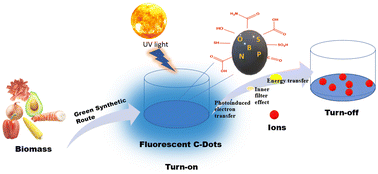Assessment of biomass-derived carbon dots as highly sensitive and selective templates for the sensing of hazardous ions
Abstract
Access to safe drinking water and a hygienic living environment are the basic necessities that encourage healthy living. However, the presence of various pollutants (especially toxic heavy metal ions) at high concentrations in water renders water unfit for drinking and domestic use. The presence of high concentrations of heavy-metal ions (e.g., Pb2+, Hg2+, Cr6+, Cd2+, or Cu2+) greater than their permissible limits adversely affects human health, and increases the risk of cancer of the kidneys, liver, skin, and central nervous system. Therefore, their detection in water is crucial. Due to the various benefits of “green”-synthesized carbon-dots (C-dots) over other materials, these materials are potential candidates for sensing of toxic heavy-metal ions in water sources. C-dots are very small carbon-based nanomaterials that show chemical stability, magnificent biocompatibility, excitation wavelength-dependent photoluminescence (PL), water solubility, simple preparation strategies, photoinduced electron transfer, and the opportunity for functionalization. A new family of C-dots called “carbon quantum dots” (CQDs) are fluorescent zero-dimensional carbon nanoparticles of size < 10 nm. The green synthesis of C-dots has numerous advantages over conventional chemical routes, such as utilization of inexpensive and non-poisonous materials, straightforward operations, rapid reactions, and renewable precursors. Natural sources, such as biomass and biomass wastes, are broadly accepted as green precursors for fabricating C-dots because these sources are economical, ecological, and readily/extensively accessible. Two main methods are available for C-dots production: top-down and bottom-up. Herein, this review article discusses the recent advancements in the green fabrication of C-dots: photostability; surface structure and functionalization; potential applications for the sensing of hazardous anions and toxic heavy-metal ions; binding of toxic ions with C-dots; probable mechanistic routes of PL-based sensing of toxic heavy-metal ions. The green production of C-dots and their promising applications in the sensing of hazardous ions discussed herein provides deep insights into the safety of human health and the environment. Nonetheless, this review article provides a resource for the conversion of low-value biomass and biomass waste into valuable materials (i.e., C-dots) for promising sensing applications.

- This article is part of the themed collections: Recent Review Articles and Nanoscale Most Popular 2023 Articles


 Please wait while we load your content...
Please wait while we load your content...